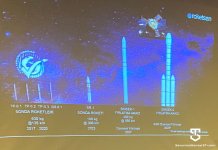Latest Thread
You are using an out of date browser. It may not display this or other websites correctly.
You should upgrade or use an alternative browser.
You should upgrade or use an alternative browser.
Indian space tech startup Pixxel Space has bagged a five-year contract from the US National Reconnaissance Office to provide hyperspectral imagery.
The NRO awarded six contracts for commercial hyperspectral imagery to BlackSky Technology, HyperSat, Orbital Sidekick, Pixxel, Planet, and Xplore. As part of the contract, Pixxel will provide hyperspectral imagery (HSI), remote sensing capabilities via modeling and simulation, and data evaluation.
The company will use on-orbit pathfinder systems and future HSI constellations to collect and provide the data, which NRO says, "will contribute to our world-class intelligence, surveillance, and reconnaissance capabilities."
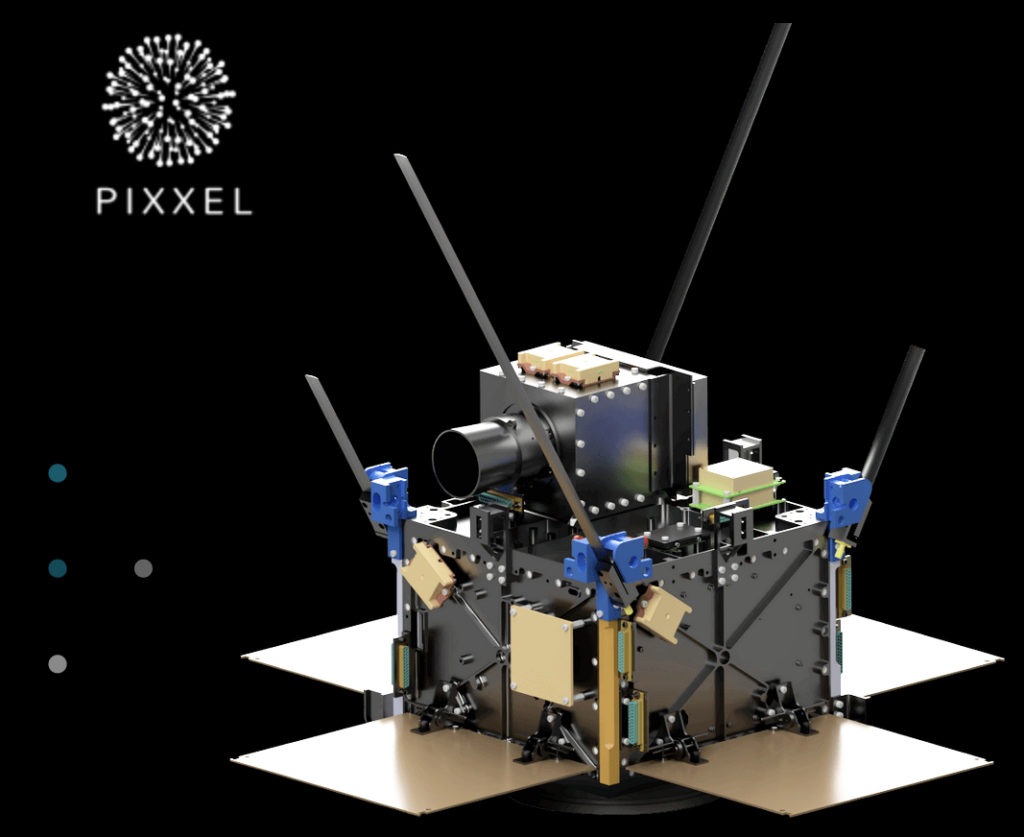
Pixxel's technology-demonstration HSI satellite
Hyperspectral images are made up of light from hundreds of colors across the electromagnetic spectrum. Since hyperspectral imaging collects many different colors of light, any given object will have a unique signature. This enables users to obtain information about each pixel in an image, with the goal of identifying objects and materials. The imagery is used in the fields of agriculture, mining, geology, and intelligence and surveillance.
“The entire team here at Pixxel is excited to begin this journey with the NRO. We are fully committed to this fantastic opportunity to offer our imaging capabilities to the organization, its partners, and the U.S. geospatial intelligence community,” Awais Ahmed, CEO and co-founder of Pixxel, said in a statement.
Pixel satellites capture images at hundreds of wavelengths in the electromagnetic spectrum and reveal key data about the health of our planet. The company said that it has seen a landmark year of growth, launching three pathfinder missions into orbit and growing its customer base across agriculture, mining, climate, oil and gas, and government.
"Congratulations to team Pixxel Space. This is a huge accomplishment and a well-deserved recognition in the field of Earth Observation. Wishing you all the best on this exciting journey & collaboration, & looking forward to seeing how you hypercharge EO," the Indian Space Association (ISpA) tweeted.

 www.indiatoday.in
www.indiatoday.in
The NRO awarded six contracts for commercial hyperspectral imagery to BlackSky Technology, HyperSat, Orbital Sidekick, Pixxel, Planet, and Xplore. As part of the contract, Pixxel will provide hyperspectral imagery (HSI), remote sensing capabilities via modeling and simulation, and data evaluation.
The company will use on-orbit pathfinder systems and future HSI constellations to collect and provide the data, which NRO says, "will contribute to our world-class intelligence, surveillance, and reconnaissance capabilities."

Pixxel's technology-demonstration HSI satellite
Hyperspectral images are made up of light from hundreds of colors across the electromagnetic spectrum. Since hyperspectral imaging collects many different colors of light, any given object will have a unique signature. This enables users to obtain information about each pixel in an image, with the goal of identifying objects and materials. The imagery is used in the fields of agriculture, mining, geology, and intelligence and surveillance.
“The entire team here at Pixxel is excited to begin this journey with the NRO. We are fully committed to this fantastic opportunity to offer our imaging capabilities to the organization, its partners, and the U.S. geospatial intelligence community,” Awais Ahmed, CEO and co-founder of Pixxel, said in a statement.
Pixel satellites capture images at hundreds of wavelengths in the electromagnetic spectrum and reveal key data about the health of our planet. The company said that it has seen a landmark year of growth, launching three pathfinder missions into orbit and growing its customer base across agriculture, mining, climate, oil and gas, and government.
"Congratulations to team Pixxel Space. This is a huge accomplishment and a well-deserved recognition in the field of Earth Observation. Wishing you all the best on this exciting journey & collaboration, & looking forward to seeing how you hypercharge EO," the Indian Space Association (ISpA) tweeted.

India's Pixxel bags 5-year deal to provide Hyperspectral imagery to US Reconnaissance Office
The company will use on-orbit pathfinder systems and future HSI constellations to collect and provide the Earth observation data.
Amazing achievement! Does anyone have any overview of the Indian rocket development?
I mean something similar to this picture:
View attachment 55460
Credit: https://www.researchgate.net/publication/358484374_Materials_for_Indian_Space_Program_An_Overview
Gessler has given an article explaining the progress so far:
A Brief History of Indian Orbital Rockets
NOTE: In this compilation I'm only going to mention orbital-rated launch vehicles, as such any sub-orbital launchers/sounding rockets will not be mentioned. I'm going to divide this into two parts. The first part will cover the history up till this point, the second part will talk about where...
 defencehub.live
defencehub.live
Here is the upcoming roadmap (Update: SSLV has been successfully launched after one failure):
The Future of Indian Orbital Rockets
As a continuation/Part-2 of "A Brief History of Indian Orbital Rockets" (https://defencehub.live/threads/a-brief-history-of-indian-orbital-rockets.8461/), this part covers those programs that are still to come. NOTE: As with the preceding article, I will only be mentioning those programs that...
 defencehub.live
defencehub.live
Particularly modular/unified launch vehicle family coming after GSLV mk3 (now called LVM3):
Pics from launch. At 5,805 kg this is also the heaviest payload orbited by an Indian rocket so far.
In his speech after, the ISRO Chairman Mr. Somnath mentioned that this launch also had a number of additions to the LVM3 on its road to human spaceflight rating for Gaganyaan.
So ISRO jumped from ASLV rocket with 150kg(LEO) to PSLV rocket with 3.200kg(LEO). That's more than 20x fold increase. Quite Impressive!View attachment 55475
Credit: https://www.researchgate.net/publication/358484374_Materials_for_Indian_Space_Program_An_Overview
Gessler has given an article explaining the progress so far:

A Brief History of Indian Orbital Rockets
NOTE: In this compilation I'm only going to mention orbital-rated launch vehicles, as such any sub-orbital launchers/sounding rockets will not be mentioned. I'm going to divide this into two parts. The first part will cover the history up till this point, the second part will talk about where...defencehub.live
Here is the upcoming roadmap (Update: SSLV has been successfully launched after one failure):
The Future of Indian Orbital Rockets
As a continuation/Part-2 of "A Brief History of Indian Orbital Rockets" (https://defencehub.live/threads/a-brief-history-of-indian-orbital-rockets.8461/), this part covers those programs that are still to come. NOTE: As with the preceding article, I will only be mentioning those programs that...defencehub.live
Particularly modular/unified launch vehicle family coming after GSLV mk3 (now called LVM3):
View attachment 55476
So ISRO jumped from ASLV rocket with 150kg(LEO) to PSLV rocket with 3.200kg(LEO). That's more than 20x fold increase. Quite Impressive!
Yes, not only was the SLV/ASLV essentially scaled up, but a large stage of it was given a much better specific impulse (Isp) with a liquid fuel stage (and the Vikas engine for it) than would have been found with retaining HTPB (solid) there.
Fully scaling with just HTPB would have given a lot less payload capability maybe around 1000kg to LEO.
fire starter
Well-known member
Last edited:
When and where did it take of?
Did we miss something?
Never seen it before.
India's PSLV to launch Europe's Proba-3 mission to unravel secrets of the Sun
India's PSLV to launch Europe's Proba-3 mission to unravel secrets of the Sun
By India Today Science Desk: The two spacecraft forming the European Space Agency’s Proba-3 mission are ready with instruments and sensors allowing them to maneuver to a millimeter-scale precision relative to one another. The spacecraft will fly into space on India's Polar Satellite Launch Vehicle (PSLV) in 2024.
The spacecraft is set to go into the testing phase where engineers will subject them to a simulated space environment. The spacecraft has been designed to demonstrate precision formation flying in space, where they will fly together maintaining a fixed configuration as a large rigid structure.
WHAT WILL PROBA-3 DO IN SPACE?
WHAT WILL PROBA-3 DO IN SPACE?

PROBA-3 Artistic Depiction
The Sun is a million times brighter than its surrounding corona, so eclipsing it is essential for coronal studies. This is what happens during a solar eclipse of the Sun by Earth's Moon. But that sporadic event lasts for only a few minutes.
As a world first, Proba-3's two satellites –the Coronagraph spacecraft and the Occulter spacecraft – will maintain formation to a few millimeters and arc second precision.
ESA said that the two probes will together form a 144-m long solar coronagraph to study the Sun’s faint corona closer to the solar rim than has ever before been achieved. This will open up continuous views of the Sun’s faint corona, or surrounding atmosphere, for scientific observation.
PSLV TO THE RESCUE
PSLV TO THE RESCUE
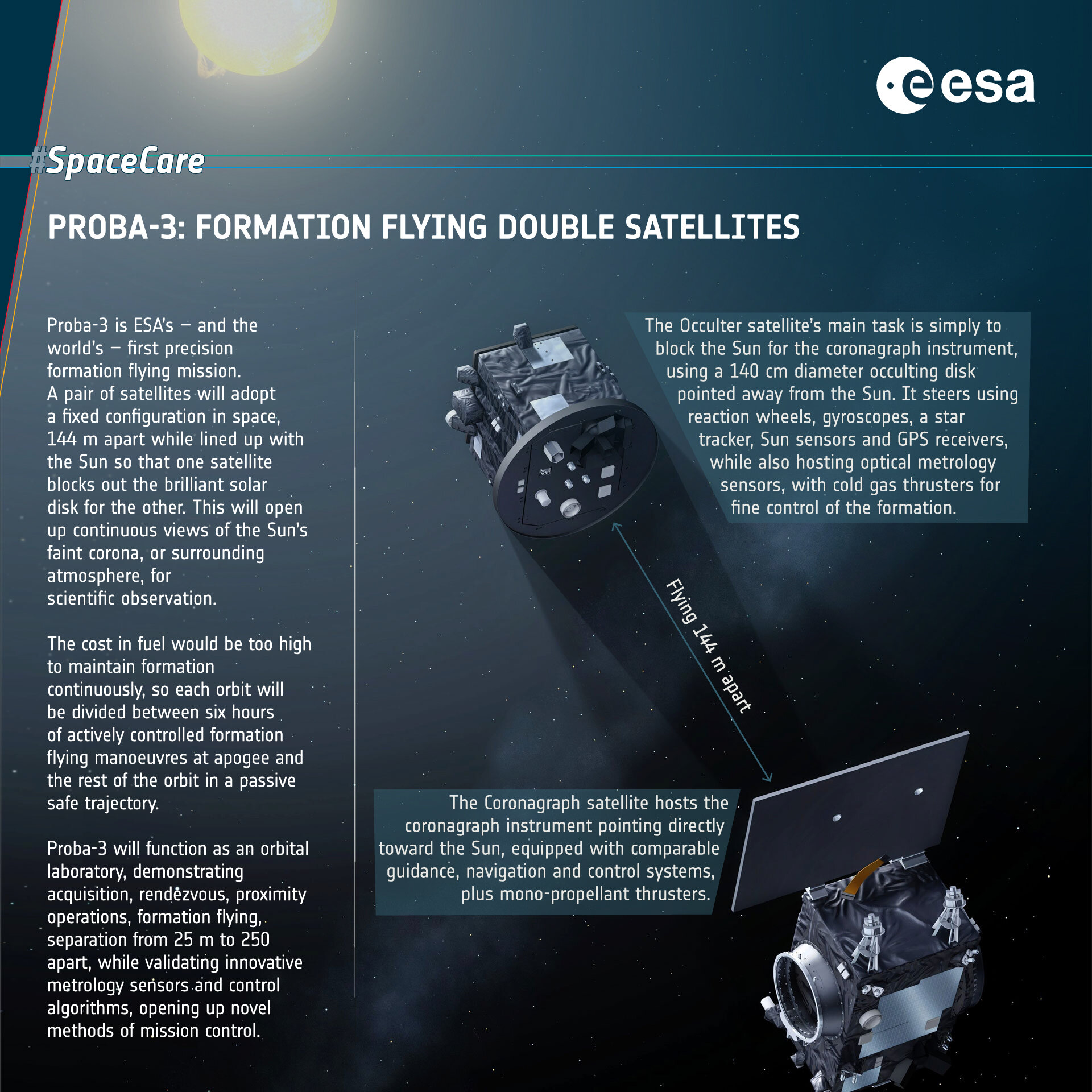
The 340-kilogram spacecraft will be deployed by PSLV in a high Earth orbit with an orbital period of 19.7 hours. They will be placed in a highly elliptical orbit of 600 x 60,530 km. After a short preparatory period, the two satellites will be separated and injected into a safe relative tandem orbit.
Known as the workhorse of the Indian Space Research Organisation, PSLV is the third-generation launch vehicle capable of placing multiple payloads into orbit in a single mission. The four-stage rocket has been used to launch various satellites into Geosynchronous and Geostationary orbits.
"Proba-3 will function as an orbital laboratory, demonstrating acquisition, proximity, operation, formation flying, separation from 25 meters to 250 meters apart, while validating innovative meteorology sensors, and control algorithms, opening up novel methods of mission control," ESA said in a statement.
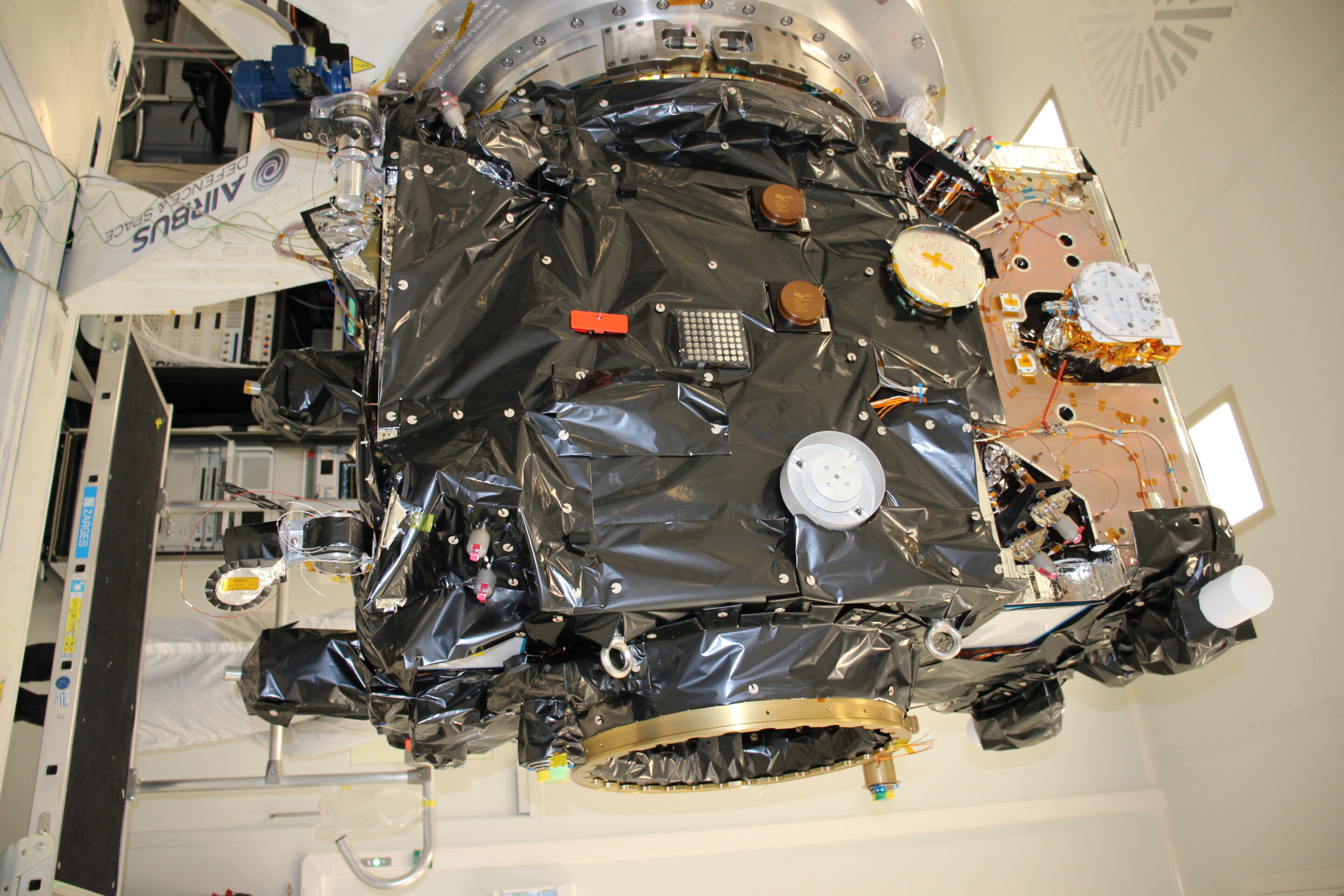
One of the two spacecraft that form part of the PROBA-3 mission in testing at ESA's facilities
The spacecraft will now be shipped to IABG in Germany for the start of a four-month environmental test campaign, simulating every aspect of the launch and space environments.

India's PSLV to launch Europe's Proba-3 mission to unravel secrets of the Sun
The 340-kilogram spacecraft will be deployed by PSLV in a high Earth orbit with an orbital period of 19.7 hours.
 www.indiatoday.in
www.indiatoday.in
Program update on the PROBA-3:
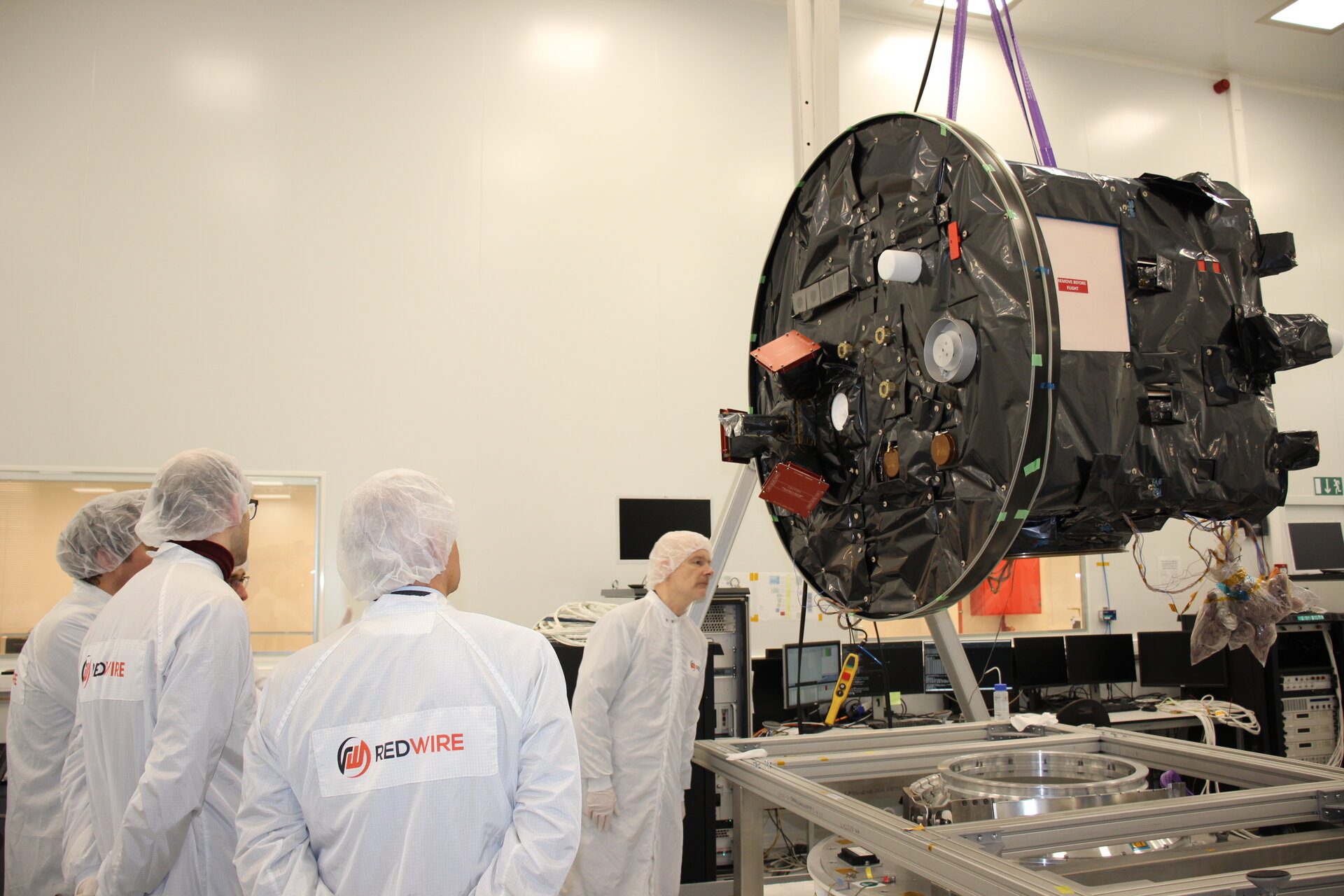
Proba-3 complete: Formation-flying satellites fully integrated
The two spacecraft forming ESA’s Proba-3 mission for precise formation flying in orbit are now complete. All the instruments and sensors allowing them to manoeuvre to millimetre scale precision relative to one another have been integrated aboard, and the pair are fully wrapped in multi-layer...
www.esa.int
When and where did it take of?
Did we miss something?
Never seen it before.
For this experiment, it was carried to altitude by a Chinook and dropped, it landed autonomously. This was the Landing Experiment (LEX).
The RLV-TD platform was first tested in 2016, launching on top of a solid rocket booster. That was called the Hypersonic flight experiment (HEX), where the craft glided at hypersonic speeds & performed a controlled splashdown in the sea.

RLV Technology Demonstration Programme - Wikipedia
Then the program was de-prioritized and the funding was slashed because the human spaceflight program (Gaganyaan) took priority. Now 7 years later it seems its back on the board as a lot of the work for the Gaganyaan program has already been completed.
In the future, it's intended to become something similar to the X-37B. I covered it in my articles:
A Brief History of Indian Orbital Rockets
NOTE: In this compilation I'm only going to mention orbital-rated launch vehicles, as such any sub-orbital launchers/sounding rockets will not be mentioned. I'm going to divide this into two parts. The first part will cover the history up till this point, the second part will talk about where...
 defencehub.live
defencehub.live
The Future of Indian Orbital Rockets
As a continuation/Part-2 of "A Brief History of Indian Orbital Rockets" (https://defencehub.live/threads/a-brief-history-of-indian-orbital-rockets.8461/), this part covers those programs that are still to come. NOTE: As with the preceding article, I will only be mentioning those programs that...
 defencehub.live
defencehub.live
With the suspension rig:


The Boeing X-40 Space Maneuver Vehicle (SMV), precursor of the X-37B, undergoing similar tests back in the day:


RLV-TD is roughly the same size as the X-40.
The Boeing X-40 Space Maneuver Vehicle (SMV), precursor of the X-37B, undergoing similar tests back in the day:
RLV-TD is roughly the same size as the X-40.
What do space planes like the X-37B even do? They don't seem very useful for reuseable satellites launch. So far the US Air Force has used the X-37B for "secret missions". I assumed it was just research but the fact that both China and India are developing thier own means that there must be some practical use for these space planes.For this experiment, it was carried to altitude by a Chinook and dropped, it landed autonomously. This was the Landing Experiment (LEX).
The RLV-TD platform was first tested in 2016, launching on top of a solid rocket booster. That was called the Hypersonic flight experiment (HEX), where the craft glided at hypersonic speeds & performed a controlled splashdown in the sea.

RLV Technology Demonstration Programme - Wikipedia
en.wikipedia.org
Then the program was de-prioritized and the funding was slashed because the human spaceflight program (Gaganyaan) took priority. Now 7 years later it seems its back on the board as a lot of the work for the Gaganyaan program has already been completed.
In the future, it's intended to become something similar to the X-37B. I covered it in my articles:

A Brief History of Indian Orbital Rockets
NOTE: In this compilation I'm only going to mention orbital-rated launch vehicles, as such any sub-orbital launchers/sounding rockets will not be mentioned. I'm going to divide this into two parts. The first part will cover the history up till this point, the second part will talk about where...defencehub.live
The Future of Indian Orbital Rockets
As a continuation/Part-2 of "A Brief History of Indian Orbital Rockets" (https://defencehub.live/threads/a-brief-history-of-indian-orbital-rockets.8461/), this part covers those programs that are still to come. NOTE: As with the preceding article, I will only be mentioning those programs that...defencehub.live
What do space planes like the X-37B even do? They don't seem very useful for reuseable satellites launch. So far the US Air Force has used the X-37B for "secret missions". I assumed it was just research but the fact that both China and India are developing thier own means that there must be some practical use for these space planes.
It's mostly strategic in nature. Some details of the orbit-adjustment capabilities of the spaceplanes are mentioned here:

Former SecAF Explains How Secret X-37 Space Plane Throws Off Enemies
The X-37B has puzzled space geeks, enthusiasts, experts and even some officials for years because of its clandestine use.
But what actual missions they perform are still officially secret. Venturing an informed guess:
- In-orbit servicing of friendly sats and/or sabotaging of enemy sats
- Snatch-and-grab enemy sats to bring home for study
- Covert observation of enemy orbitals
- Deployment of covert ASAT capabilities (arm, kinetic payload etc.) by releasing the payload then ducking below radar horizon
Skyroot Aerospace successfully test-fires 3D-printed cryogenic engine for a record 200 seconds
Skyroot Aerospace successfully test-fires 3D-printed cryogenic engine for a record 200 seconds
The first Indian private company to send a rocket into space has successfully tested fully-cryogenic rocket engine at a private propulsion test facility
The first Indian private company to send a rocket into space has successfully tested fully-cryogenic rocket engine at a private propulsion test facility
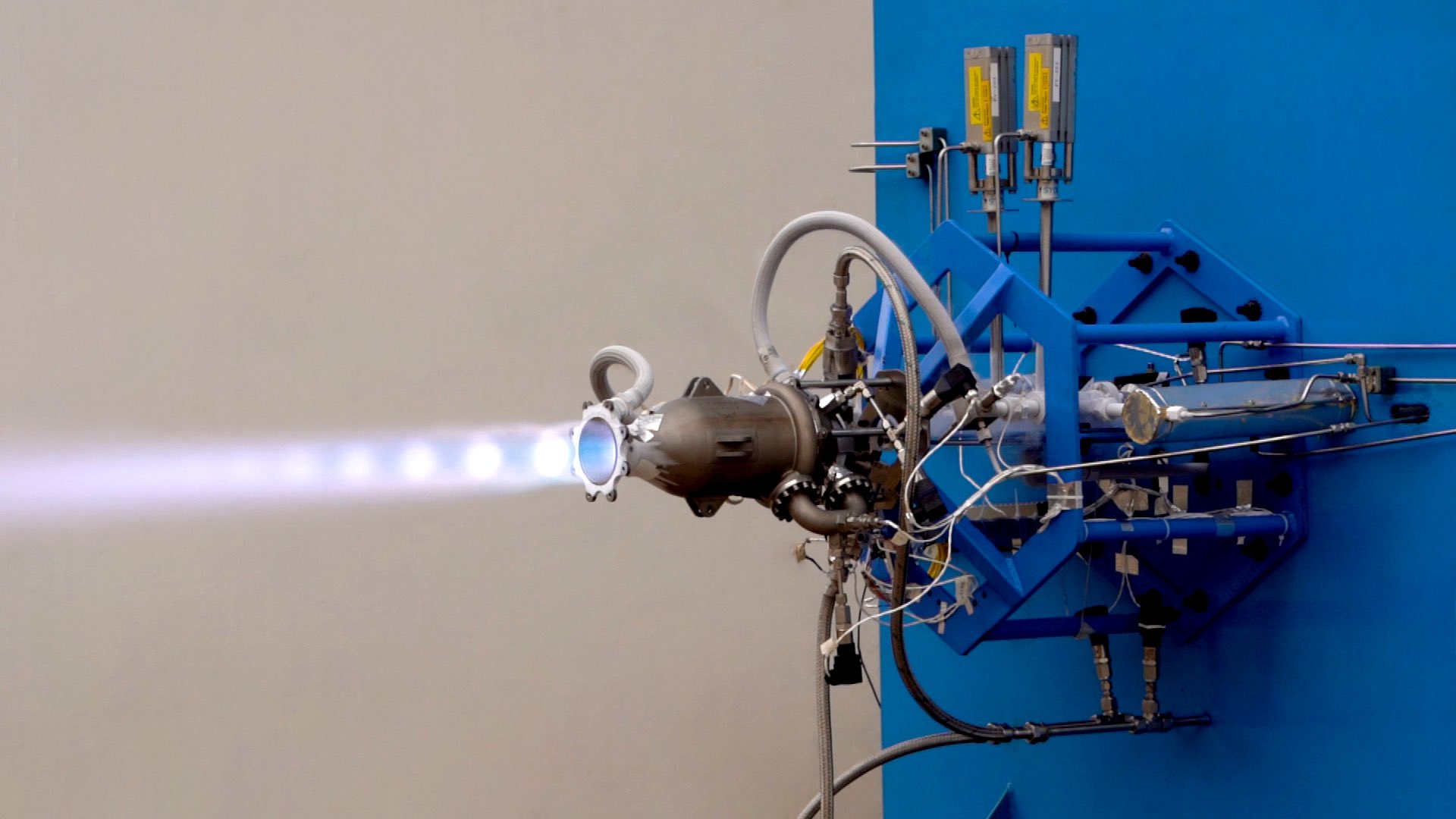
Skyroot Aerospace, the pioneering private rocket builder, achieved a major milestone by successfully test-firing an advanced fully 3D-printed cryogenic engine for a record 200 seconds. The endurance test of ‘Dhawan-II’ was carried out at Solar Industries propulsion test facility in Nagpur, Maharashtra, using indigenously developed mobile cryogenic engine test pad, it was announced on Tuesday.
This achievement follows the November 2022 launch of Vikram – S, which made the firm, the first Indian private company to send a rocket into space. Dhawan-II engine builds upon the foundation laid by the firm’s first privately developed fully-cryogenic rocket engine, the 1.0 kN thrust Dhawan – I, successfully test fired in November 2021. The engine series is named in honour of Dr. Satish Dhawan, the eminent rocket scientist who had played a crucial role in development of Indian Space Program, said a press release.
The cryogenic rocket engines, which greatly enhances payload-carrying capabilities, uses two high-performance rocket propellants, Liquid Natural Gas (LNG) and Liquid Oxygen (LoX), which require cryogenic temperatures (below -150° C) for storage and operation. Both fuels are environmentally friendly compared to other solid, semi-cryogenic and hypergolic propellants used in rocket industry.
“Dhawan-II’s successful test is a landmark achievement. We are proud to be at the forefront in developing cutting-edge cryogenic technologies and advanced technologies like 3D printing and green propellants. It will enhance Vikram launch vehicles payload capacity,” said founders CEO Pawan Kumar Chandana and COO Naga Bharath Daka.
“Our 3D printed Dhawan – II engine also uses a 3D printed torch igniter and cryo-injection valve with quick response time. We could get valuable data for next generation cryogenic engine technology with LNG as fuel,” informed veteran rocket scientist V. Gnanagandhi.
Skyroot aiming to make spaceflights affordable, reliable and regular, as multiple launch missions progressing including the Vikram - I. to be launched by 2023 end and Vikram – II by next year. The engine development was partly supported by NITI Ayog’s ANIC-ARISE program which promotes technologies including the use of green rocket propellants, added the release.

Skyroot Aerospace successfully test-fires 3D-printed cryogenic engine for a record 200 seconds
Skyroot Aerospace, India’s first private company to successfully launch a rocket into space, has achieved a record 200 second test firing of its 3D printed fully cryogenic engine at a propulsion test facility

BNN Bloomberg - Canada Business News, TSX Today, Oil and Energy Prices
Get the latest Canadian business news, including TSX updates, changes to oil and energy prices, and Bank of Canada coverage. Explore stock market investing and get expert financial insights on investment portfolio strategies.
(Bloomberg) -- India is muscling in on the increasingly lucrative business of space, taking advantage of the geopolitical isolation of China and Russia to pitch itself as a reliable alternative to SpaceX.
State-owned NewSpace India Ltd. launched three dozen communications satellites last month from an island off the nation’s eastern coast for OneWeb Ltd. The move not only salvaged the UK satellite company’s bid to create a global broadband internet network in the skies, but also signaled India’s ambitions in the sector.
Demand for high-speed internet delivered from space has made launching satellites into orbit a prosperous business. By 2025, the so-called space economy is projected to grow to $600 billion from $447 billion in 2020, according to Ernst & Young estimates.
Along with Elon Musk’s SpaceX, Russia and China have been the main providers of satellite launches, given their long-running state space programs. But the war in Ukraine and Beijing’s tensions with the US mean they’re now off limits to many would-be customers. OneWeb turned to India after Russia scuppered the original launch last year, taking 36 of its spacecraft hostage.
At the same time, France’s Arianespace has suffered problems getting its newest rocket ready for use. And Virgin Orbit Holdings Inc., the satellite-launch company tied to British billionaire Richard Branson, said last week that it was ceasing operations indefinitely following a launch failure in January.
“If SpaceX is full, busy or expensive, you have to look elsewhere – and you can’t look at China,” said Dallas Kasaboski, principal analyst with Northern Sky Research, a space research and consulting firm. “China can’t work with North America and the US drives the majority of demand.”
“Politically, India is in a much better place,” he said.
Chinese rockets aren’t good options for many satellite operators, partly because of growing concerns about Beijing accessing Western technology. By contrast, India has moved closer to the US and other regional powers, including Australia and Japan, and the country’s launches cost less than other rivals.
Developing the space sector is a key plank of Prime Minister Narendra Modi’s “Make in India” campaign, which aims to position the world’s fifth-largest economy as a top destination for technological innovation. His administration has tried to make India’s space agency more business friendly by encouraging the growth of startups.
“Demand is so huge,” said D. Radhakrishnan, the chairman and managing director of NewSpace, which was created in 2019 as the commercial arm of the national space agency, the India Space Research Organisation. “There’s going to be a lot of shortage of the heavy-lift launchers that will be required.”
Taking on China
NewSpace should help India compete on the global stage. The March 26 launch follows a successful operation in October, when the company launched another 36 satellites for OneWeb. NewSpace is ramping up production of India’s largest domestically developed rocket — the LVM3.
Neil Masterson, the chief executive of OneWeb, said NewSpace has “a real opportunity to be a mainstream commercial launch provider.” Last fiscal year, the company posted revenue of 17 billion rupees ($210 million) and profit of 3 billion rupees ($41 million). NewSpace provided satellite launch services for 52 international customers.
More broadly, India’s industry is on track for significant growth. In 2020, the government eased rules for private sector satellite and rocket companies, allowing them to carry out independent space activities instead of being solely the suppliers to ISRO. The reforms mean that startups can also access ISRO’s facilities, such as launchpads and laboratories. By 2025, the value of India’s satellite launch services could almost double to $1 billion.
India still has far to go before it catches China. As of March 2020, China owned 13.6% of all earth-orbiting satellites, compared to 2.3% for India, according to the Center for Strategic and International Studies, a think tank in Washington.
Last year, China conducted 64 launches, the Communist Party-backed newspaper Global Times reported. While most private companies in China are still developing their rockets, a few have managed orbital launches on their own. In March 2022, the Beijing-based startup GalaxySpace placed six communications satellites into low-earth orbit and rival Galactic Energy, also headquartered in China’s capital, added five more in January.
By comparison, India managed five similar launches last year — all of them by ISRO or NewSpace. Only a few are planned for 2023.
Ensuring Reliability
In the past, India’s rockets have also suffered from reliability issues. The country’s success rate in recent years of about 70% compares poorly to rates in the 90s for rockets from the US, Europe, Russia or China, according to Jonathan McDowell, an astrophysicist at the Center for Astrophysics, which is operated by Harvard University and the Smithsonian Institution.
When choosing to launch in India, he said, “you’re accepting a slightly higher risk of failure.”
But even with that backdrop, India is doing well, he said. The nation remains a popular choice for cost-efficient launches: In 2013, India sent an orbiter to Mars for a 10th of the price of a NASA probe that went the same year.
“There aren’t many players that have a large-capacity launch vehicle that’s cheap,” McDowell said. “And that’s not China or Russia.”
--With assistance from Thomas Seal.
©2023 Bloomberg L.P.




